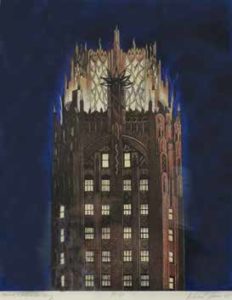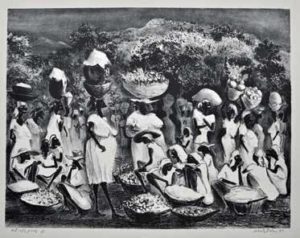AP Art – Ask the Artsperts – November 2016

Juliana and Kristine Meek
Dear Artsperts:
My wife and I have a print hanging in our kitchen and I noticed the other day it says “AP” in the lower left corner in pencil.
What does the AP stand for? Is it worth more because it says “AP” instead of a number?
Signed,
Penciled In

Lithograph print labeled “AP 1 /2” by Richard Haas, “General Electric Building” 22” x 17”, 2005
Dear Penciled,
The “AP” you see written on your print stands for “Artist Proof”. This means the print was not included in the numbered edition. It may or may not be identical to the prints in the numbered edition corresponding to this image. There is a chance that the artist made changes between this “proof” and the finished numbered edition, though in most contemporary cases the Artist Proofs are the same in appearance to the numbered works.
In the early days of printmaking, a printer’s plate, particularly in the case of copper plate etchings, would dull over the use and the most well-defined prints would be the first ones off the press. Because of the dulling and to ensure print quality, proofs would be pulled at the beginning and throughout the process. These proofs were called the artist’s proofs and belonged to the artist. The remaining number prints belonged to the printmaker who purchased the rights to create a limited number of prints from the artist’s work.
Today, offset lithographic prints or Giclée prints (ink-jet printing) makes each print identical in quality from the very first to the last print, even if there are a thousand prints. However the notion that at Artist Proof is somehow special and therefore worth more, has remained in popular belief.

Lithograph print by Adolf Dehn labeled “artist’s proof”, “Haitian Market Women”, edition of 30, 13” x 17”, 1949
Typically today an edition of lithograph, serigraph or Giclée prints will include an overage of about 10 percent – 20 percent that an artist can have produced in addition to the numbered works and these can be labeled “Artist Proof”. So in an addition of say 250 limited edition works there can also be 50 more identical works with the words “AP” instead of a number. So some people think that an AP work is rarer since it is one out of 50 instead of one out of 250, though there were 300 identical works created. In the case of European prints it may be “EA”. This can also be seen as “TP”, which is a trial proof that is a proof for the printmaker or “PP” for printer’s proof.
While an Artist Proof does not need to be numbered, it may be numbered e.g. A.P. 37/50. However, the increased desirability and value of an artist proof is a historical notion that has not been true since prior to the 1940’s when copper plating fell out of use. Today all prints are identical. The only difference is in ownership, with the artist’s proofs belonging to the artist and the numbered prints belonging to the printmaker. But ownership of the works has no bearing on the value.
Sincerely,



Leave a Reply
Want to join the discussion?Feel free to contribute!